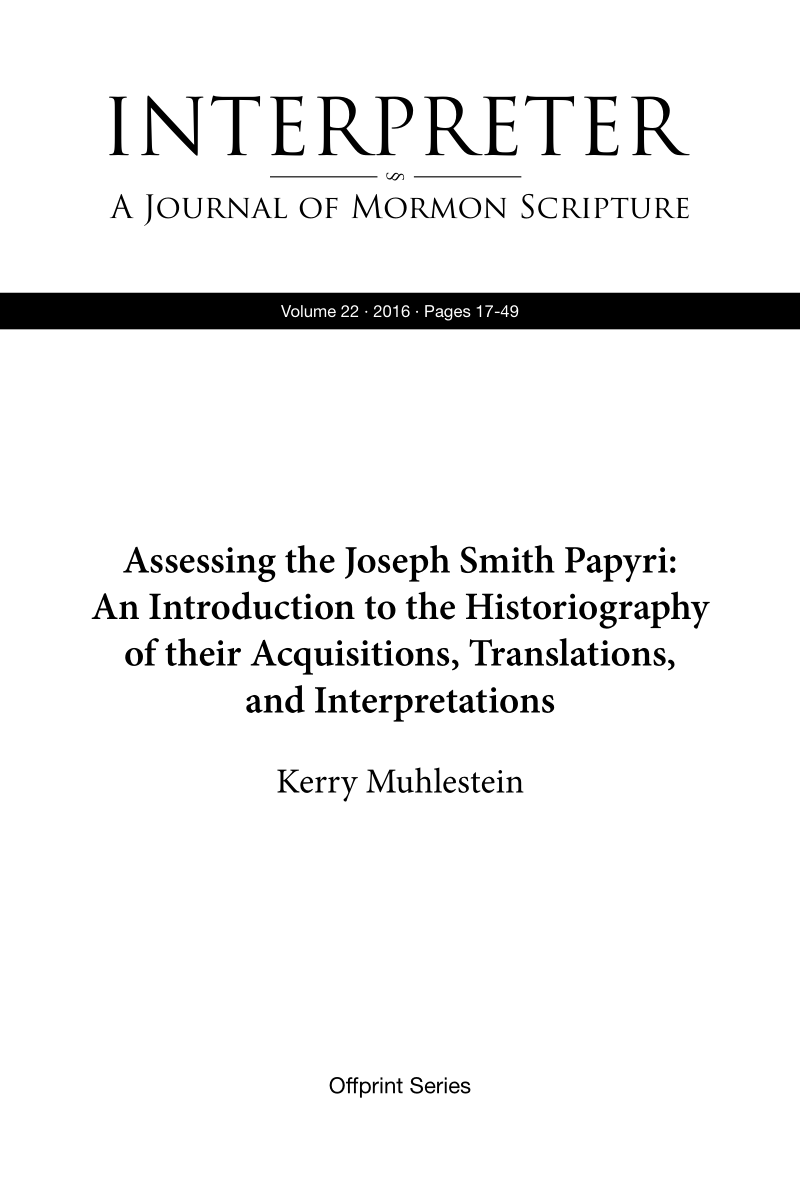Muhlestein discusses implications of Abraham 1:12, 14 for the relationship of text with facsimiles.
- Type
- Academic / Technical Report
- Source
- Kerry Muhlestein LDS
- Hearsay
- DirectSecondary
- Reference
Kerry Muhlestein, "Assessing the Joseph Smith Papyri: An Introduction to the Historiography of their Acquisitions, Translations, and Interpretations," Interpreter: A Journal of Latter-day Saint Faith and Scholarship 22 (2016): 29–31
- Scribe/Publisher
- Interpreter: A Journal of Latter-day Saint Faith and Scholarship
- People
- Kerry Muhlestein
- Audience
- Reading Public
- Transcription
The text of the Book of Abraham does make reference to a picture. It says the fashion (or drawing) of the altar and idolatrous gods is “at the beginning,” presumably of the record or papyrus on which the text was written. The first time this statement is clearly said is Abraham 1:12. Believing Latter-day Saints often assume that this line drawing attention to the vignette must be part of the earliest manuscript, but it is not entirely clear that this must be the case. The earliest attestation of the text of the Book of Abraham is a manuscript that is a second or third generation copy of the original dictation of the text. In this manuscript part of the statement referring the reader to see a depiction of the altar at the “commencement” of the record is inserted between the lines of the text, suggesting that it may have been added as an afterthought. However, the second mention of the drawing (Abraham 1:14) appears as part of the normal flow of the text. While it is possible that the interlinear text indicates this is a later addition, that conclusion is less likely. The manuscript on which the line about the vignette was added does not actually have any drawings on it. It would not make sense to create a reference to a picture for a manuscript that does not have a picture on it. Rather, it seems more likely that the line about the picture had been accidentally left out and was re-inserted above the line. Moreover, the reference to the drawing that occurs just two verses later does not appear to be a later addition. The reference could not refer to the way it was printed in the Times and Seasons publication because that took place in 1842, and the text in question appears in 1835. Taken together, these bits of evidence suggest that the reference to the altar “at the beginning” is a line from the translation of the papyrus, though we cannot be certain. If this is true the reference to the “beginning” indicates that the vignette depicting the altar and idols is not adjacent to the text but some distance from it — at the beginning.
The line about seeing the representation at the beginning of the text is 540 English words into the text of the Book of Abraham. The Egyptian text in question is read right to left, with about two inches of text on the right-hand side of the vignette and several inches of it on the left-hand side. On a papyrus with hieroglyphs, this would have been only a few inches in, close enough to any vignette for no need to refer the reader “to the beginning.” For example, on JSP I, X, and XI (the fragments of papyri that contain the text adjacent to the Sacrifice of Abraham Vignette), 540 English words of translation are about five inches into the text. Because about two inches are on one side of the vignette, this would make the line in question, if it were translated from that papyrus, or if Joseph Smith thought or pretended he was translating from that text, about three inches away from the vignette, placing it so close to the vignette that one would not refer to it as being at “the commencement” or “beginning.” If Joseph Smith were translating using something akin to the “Egyptian Alphabet and Grammar,” which suggests many English words be translated for each Egyptian character, the line about “the beginning” would have been right next to the vignette. The reference to a picture at the beginning makes the most sense if it is situated further from the text than one to three inches. Thus, our first line of questioning, that of examining what the text says about its relationship to the drawing, leads away from the common assumption and points towards the text and vignette not being adjacent to one another.
- Citations in Mormonr Qnas
The B. H. Roberts Foundation is not owned by, operated by, or affiliated with the Church of Jesus Christ of Latter-day Saints.

